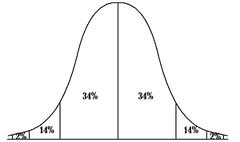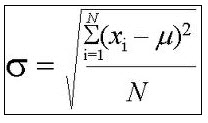Inverse Cumulative Normal Probability Calculator
Instructions: Compute the inverse cumulative normal probability score for a given cumulative probability. Give a cumulative probability \(p\) (a value on the interval [0, 1]), specify the mean (\(\mu\)) and standard deviation (\(\sigma\)) for the variable \(X\), and the solver will find the value \(x\) so that \(\Pr(X \le x) = p\).
More about this Inverse Cumulative Normal Probability Calculator
This Inverse Cumulative Normal Probability Calculator will compute for you a score \(x\) so that the cumulative normal probability is equal to a certain given value \(p\).
How does this invnorm calculator?
In simple words, this calculator finds a z-score associated to a given probability value. The invnorm calculator z-score that is found is then converted to the required X score
Mathematically, we find \(x\) so that \(\Pr(X \le x) = p\).
Example: Assume that \(X\) is a normally distributed variable, with mean \(\mu = 500\) and population standard deviation \(\sigma = 100\). Let us assume we want to compute the \(x\) score so that the cumulative normal probability distribution is 0.89. First, the z-score associated to a cumulative probability of 0.89 is
\[ z_c = \Phi^{-1}(0.89) = 1.227\]This value of \(z_c = 1.227\) can be found with Excel, or with a normal distribution table. Hence, the X score associated with the 0.89 cumulative probability is
\[ x = \mu + z_c \times \sigma = 500 + 1.227 \times 100 = 622.7\]Can you use invNorm without calculator?
The short answer is NO. Normal probability calculations are complex mathematical operations for which you need either a normal table, or a statistical software, or a hand calculator.
Inverse normal distribution
The normal distribution and its inverse are broadly used in statistics, and it is worth it having a deep understanding of it.
The normal distribution computes probabilities associated to scores, where the inverse normal distribution computes scores that are associated to given probabilities.
Should I use a normal table or a calculator?
By far, a calculator will be better, with some caveats:
- Using a inverse normal calculator will provide far more precise results than a table
- Tables are usually accurate up to 4 or 5 digits, and calculators are typically accurate up to 15 digits most typically
- With a calculator you can type in any value, whereas with a table you may need to interpolate for values that are not actually in the table
- Sometimes instructors asks specifically to use table values, so in that case you will need to learn how to use them
The Standard Normal Distribution
If you are dealing specifically with the standard normal distribution, you could check this Inverse Cumulative Standard Normal Probability Calculator .
Other graph creators that you could use are our normal probability plot , normal distribution grapher or our Pareto chart marker .

Example: Inverse Cumulative Normal distribution
Question: Assume that X has a normal distribution with a mean of 12, and a population standard deviation of 3.5. Find the score of the distribution such that 45% of scores of the population are to its left.
Solution:
The following are the population mean \((\mu)\), population standard deviation \((\sigma)\) and cumulative probability provided:
| Population Mean \((\mu)\) = | \(12\) |
| Population Standard Deviation \((\sigma)\) = | \(3.5\) |
| Cumulative Probability = | \(0.45\) |
We need to find a score \(x\) so that the corresponding cumulative normal probability is equal to \(0.45\). Mathematically, \(x\) is such that:
\[\Pr(X \le x) = 0.45\]where \(X\) is normally distributed with a population mean \(\mu = 12\) and a population standard deviation \(\sigma = 3.5\)
First, we corresponding \(z\) score so that the cumulative standard normal probability distribution is equal to \(0.45\). So we are looking for \(z_c\) such that
\[\Pr(Z \le z_c) = 0.45\]By using a normal distribution table (or some statistical calculator like Excel can be used too), we find that \(z_c = -0.13\). Hence, the X score associated with a cumulative probability of \(0.45\) is
In other words, we have found a z-score \(z_c = -0.13\) with the property that
\[\Pr(Z \le -0.13) = 0.45\]Hence, the X score associated with a cumulative probability of \(0.45\) is
\[ \begin{array}{ccl} X & = & \mu + z_c \times \sigma \\\\ \\\\ & = & 12 + (-0.13) \times 3.5 \\\\ \\\\ & = & 11.545 \end{array}\]Therefore, the \(X\) for which the cumulative normal probability is \(0.45\) is \( X = 11.545\).

